
Forage plant: 5 vegetables for animals
Some vegetables from the vegetable garden are grown as fodder to feed animals.
Contents
If you prefer chickens, rabbits, sheep, donkeys, or other livestock over cats and dogs as pets, this article is for you. You may be wondering how to best feed them, especially with produce from your vegetable garden. The forage plants such as ryegrass, alfalfa, fescue, or clover certainly make them happy, but did you know that you can also grow forage vegetables? These supplements, which are very high in fibre, are highly appreciated by herbivores and omnivores for their both tasty and energy-rich qualities. Moreover, they provide a supplement at a time of year when other forage plants become scarcer. Easy to plant and grow, these forage vegetables are valuable for both their roots and their foliage. To ensure they are well preserved and digested by the animals, these forage vegetables should be harvested after morning dew and dried before storage. Discover our selection of 5 forage vegetables that your animals will surely enjoy.
Forage cabbage, rich in nitrogen, calcium, and phosphorus
Forage cabbage (Brassica Oleracea) is characterised by its lack of heading. As it grows on tall stems that can reach up to one metre in height, it is often referred to as “cabbage tree”. It is a branched cabbage with wide, fleshy stems and leaves rich in nitrogen, calcium, and phosphorus. Thus, it has a very good nutritional value for cattle and sheep. Additionally, it is high in dry matter.
Very resistant to cold and frost (it can withstand temperatures as low as -14 °C), but also to heat and drought, it is harvested during winter, from September to March, as needed. Simply separate the leaves from the stems by breaking them off.
Forage cabbage is planted in soil rich in organic matter, in July-August. Choose a sunny location, as with most cabbages. Sowing can also be done from March to May in a nursery to be transplanted into the ground one and a half to two months later. Sow in rows spaced 40 cm apart. When the seedlings have 3 to 4 leaves, it is necessary to thin them out, leaving only two plants every 50 to 60 cm.
Watering is only necessary in case of drought, especially if you apply mulch.
Our favourite:
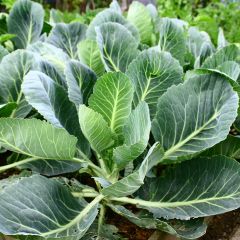
Brassica oleracea Proteor INRA seeds - Wild cabbage - Vilmorin Seeds
- Altezza a maturità 1 m
Read also
Cabbage: planting, sowing and harvestForage carrot, highly valued in rabbit hutches
If you keep chickens and rabbits at home, forage carrots prove to be an excellent feed. Naturally, rabbits love them. As for chickens, they enjoy both the foliage and the root, which can be cooked if desired. Forage carrots are a rich dietary supplement, high in vitamins A (carotin), B1, B2, and C, as well as fibre and sugars, making them perfect for enriching your animals’ daily rations. This is especially important during times when greenery is scarce.
Another advantage of these forage carrots lies in their high productivity. Additionally, the roots of these forage carrots can reach lengths of up to 30 centimetres. They have many benefits for your vegetable garden. Moreover, their hardiness allows them to be grown anywhere. Finally, they have good winter storage capabilities, either in the ground (though this means occupying a plot for a long time!) or in a sand silo that is slightly moist, in a frost-free and ventilated space. You can then take what you need as your animals require.
As for sowing, it can be done in stages from March to July for a harvest until November. You can also sow these forage carrots in October-November for a harvest as early as the following spring in May. Like all carrots, forage carrots prefer light, rich, deep soils that are free of stones. Therefore, autumn digging should be deep, and the soil should be enriched with compost or well-decomposed manure.
Our favourite varieties:
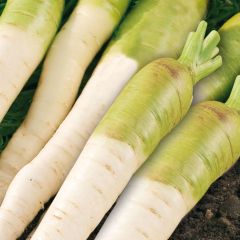
White fodder carrot with green collar - Daucus carota
- Altezza a maturità 30 cm
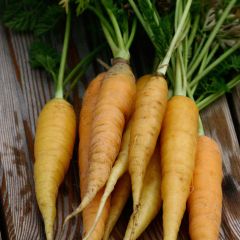
Fodder carrot Jaune du Doubs - Daucus carota
- Altezza a maturità 30 cm
Beetroot, a forage vegetable used for a long time
Here is a forage vegetable that has proven itself for centuries. Indeed, forage beet (Beta vulgaris subsp. maritima) has long been used as feed for animals, including sheep, cattle, goats, as well as horses, chickens, and rabbits. It must be acknowledged that forage beet has much to offer, particularly its high palatability due to its sugar content. It is therefore a significant source of energy, especially during winter when greenery is scarce. It also possesses excellent digestive properties and is rich in vitamins and minerals, notably potassium. Both the fleshy roots and leaves are edible. Its long shelf life in a cool, dark place like a cellar or pantry makes it a useful food source in winter.
Forage beet should be sown as soon as the risk of frost has passed, starting from mid-March in the milder regions, or from May elsewhere. Sowing can continue until July to stagger the harvests over time. Like its relatives, the garden beets, forage beet prefers cool, loose soils rich in potash. Therefore, you can enrich the soil with a bit of ash, compost, or manure. Additionally, it is sensitive to competition from weeds. We recommend applying mulch to maintain moisture and limit the growth of adventive plants.
Our favourite varieties:
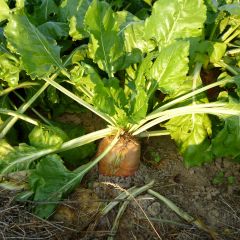
Fodder Beet or Mangelwurzel Vauriac Yellow Giant
- Altezza a maturità 35 cm
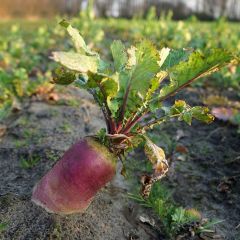
Fodder Beet or Mangelwurzel Red Mammoth
- Altezza a maturità 25 cm
Swede for a (nearly) year-round harvest
Like beetroot, the forage turnip (Brassica rapa) has long been part of animal feed. All animals enjoy its fleshy, spherical or elongated root depending on the varieties. They can also consume the foliage. It is a vegetable known to be rich in iron and calcium, as well as vitamins A, B5, B6, and C.
The forage turnip is sown from March to May and from July to August for a harvest two to three months later, before the first frosts for the later varieties. They can be stored for several months in a silo, in dry sand, and in a cool, dark, and ventilated place.
To grow properly, the forage turnip, like garden turnips, needs loose, light, rich, and non-calcareous soil. It is sensitive to frost and drought, as well as full sun. Since it requires regular watering, mulching is recommended. This mulching will also help limit the appearance of weeds, which forage turnips do not appreciate.
Our favourite variety:

Turnip Norfolk Red Top
- Periodo di fioritura July to October
- Altezza a maturità 30 cm
Rutabaga, the swede to be rehabilitated for animals
Root vegetable closely related to the turnip, the swede (Brassica napus subsp. rapifera) is distinguished by a more tapered collar, red or green depending on the varieties, and a rounder root. It is a forage vegetable appreciated by cattle and sheep, as well as horses. However, it should not be overfed due to the risk of bloating. Moreover, it is a vegetable rich in fibre, potassium, calcium, and phosphorus, as well as provitamin A and vitamin C. It has a high yield.
The swede is a vegetable that can be grown throughout France due to its hardiness down to -10 °C. Sowing takes place from May to July for a harvest from October to December. Once harvested, the swede stores well in a silo. The turnip prefers well-manured, finely worked soils, and a sunny location. It requires little care apart from hoeing to remove weeds.
Our favourite varieties:
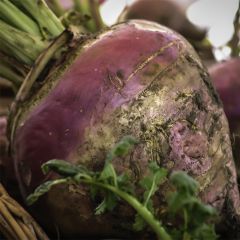
Swede Champion Purple Top - Rutabaga
- Altezza a maturità 30 cm
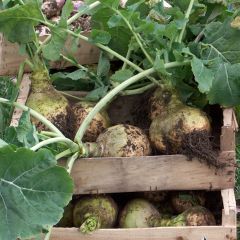
Wilhemsburger Rapeseed (with green neck) - Vilmorin seeds - Brassica napus
- Altezza a maturità 30 cm
- Subscribe!
- Contents
































Comments